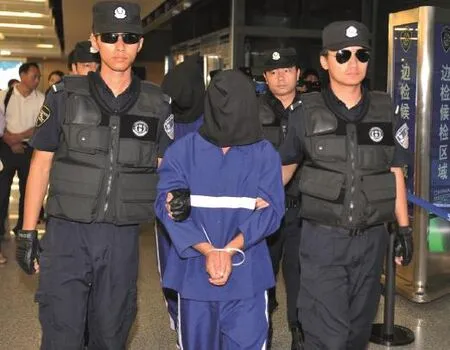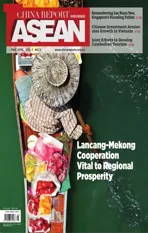Lancang-Mekong Joint Drug Fight Applauded
2016-09-26ByWangFengjuan
By Wang Fengjuan
Lancang-Mekong Joint Drug Fight Applauded
By Wang Fengjuan
drug, for China and the world, is a serious and heavy topic. At a special session of the United Nations General Assembly on drugs in April 2016, Guo Shengkun, China’s State Councilor, Head of National Anti-Drug Commission and Minister of Public Security, said that the Chinese government is firmly committed to fighting drugs and China will take an active part in international ethorts to combat drugs.
The Golden Triangle border area of Myanmar, thailand and Laos is one of the world’s largest sources of drugs. Located in the Lancang-Mekong region, which provides quick links to China, Laos, Cambodia and Vietnam, this area serves as an important channel for drug-related crimes,firearms smuggling, gambling and human trafficking.
Since the Golden Triangle has been a disaster hit area of global drug smuggling,ASEAN nations have always regarded the fight against narcotics and drug-related crimes one of the top priorities of regional security and integration.
Joint Anti-Drug Campaigns
The Golden Triangle has been haunted by problems related to drugs for a long time. From Lo Hsing-han, who ran drugs from Myanmar on and off from the 1970s to the 2000s and made the region a world-famous location for drugs production, to Khun Sa, who was dubbed the region’s “Opium King”, all of the region’s drug traffickers have relied on the Mekong River as a means of transportation for drugs. For years, drugs have jeopardized the security and stability of the Mekong waterway, as well as the health and well-being of the local people.
Li Hong, representative of the Permanent Mission of the People’s Republic of China to the United Nations Economic and Social Commission for Asia and the Pacific(ESCAP), noted that the Mekong waterway is not only an important link of economic and trade exchanges between China, Laos,Myanmar and thailand, but also one of the most important transport corridors of the ASEAN-China Free Trade Area.
In 2013 and 2015, under the guidance of a Mekong law enforcement and security cooperation mechanism, law enforcement departments of China, Laos, Myanmar and Thailand conducted anti-drug campaigns code- named “Safe Passage”. The first one was organized by China, during which the drug-control departments of each of the four countries selected a crack team of enforcement officials, facilitating information exchange, conducting case-based coordination and joint law enforcement operations.
Thailand sponsored the second campaign, which placed particular importance on drug-related information exchanges.
The two operations resulted in 10,455 arrests and the seizure of 35.7 tons of drugs,curbing the presence of international criminals in the region.
These successes did much to guarantee regional security and stability in the Golden Triangle, improving the sustainable development of Mekong countries as well as people’s lives in a pragmatic manner. Since the operations, the number of large drug-smuggling cases have dropped dramatically.
China in International Cooperation
“China is the key to ethective drug control cooperation in the Mekong region,” said Jeremy Douglas, Regional Representative of the United Nations Office on Drugs and Crime (UNODC) for Southeast Asia and the Pacific. China has always participated in international cooperation on drug control in the Lancang-Mekong region, he added.the ethects China has had on curbing smuggling has been significant.
The drug control mechanism established in the region is one of the most important multilateral platforms for combating crimes in the region. the UNODC has acted as the“6+1” member of the mechanism, offering its long-term support. that has done much to ensure the longevity of such operations.the current mechanism has been functional for 23 years.

Three suspects of the Mekong River transnational drug trafficking case arrested in Laos being in police custody in Yunnan Province
Over the past 20 years, China has contributed US$1 million to the UNODC each year. China’s drug control participation and influence has continuously increased, particularly in the Lancang-Mekong region.
The Chinese Government participated in the special sessions of the United Nations General Assembly on drugs in 1998 and 2016, and also sponsored the Centennial of the International Opium Commission in 2009. With these important multilateral conferences, China has demonstrated its anti-drug stance to the world, calling on the international community to increase investment in drug control measures and conduct international cooperation to jointly address the world’s drug problem.
China played an active role in publishing the Memorandum of Understanding on Drug Control in the Greater Mekong Sub-region, as well as a role in establishing and improving the ASEAN and China Cooperative Operations in Response to Dangerous Drugs (ACCORD). From 1998 to 2016, China signed inter-governmental and anti-drug cooperation agreements with 20 countries, as well as several multilateral agreements. China also signed 14 inter-departmental drug control cooperation agreements with 12 countries, which has improved bilateral cooperation and improved legal basis for prosecution. China has established a mechanism for annual drug-control meetings with the United States, Russia, Laos,Myanmar, thailand, Vietnam and Cambodia to develop all-round cooperative operations.
Major Xaimoungkhoun Souliyavong,Director of Law Enforcement for the Lao National Commission for Drug Control and Supervision (LCDC), expressed his heartfelt thanks for China’s anti-drug assistance to Laos.
“the Chinese Government has provided technical assistance and training to Laos. Lao drug police has received training in police training schools of Yunnan, Shandong and Zhejiang Provinces,” said Souliyavong.“China also helped build the Oudomxai drug rehabilitation center and provided aid equipment and vehicles. Theses measures have effectively enhanced the law enforcement capacity of Laos’ anti-drug institutions.”
As most of China’s inbound drugs originated in the Golden Triangle, the Chinese Government has increased the interception of inbound drugs, while promoting the remote detection of poppy plants and replacing poppy plants with other crops. China has othered technical and financial aid to officials in the traditional poppy-planting regions in Myanmar and northern Laos,investing a total of 1.6 billion yuan (US$250 million). So far, alternative crops have covered 233,300 hectares of cropland, helping local people out of poverty and reducing the local area’s economic dependence on the drug trade.
In addition, the Chinese Government provided 20,000 tons of rice as assistance to Myanmar in 2006 and 2008. Myanmar’s Mandalay police command center, fully-funded by the Chinese Government and outfitted with Chinese equipment, has been put into operation.
For Laos, on the basis of the assistance of US$600,000 for the building of the Oudomxai drug rehabilitation center,China provided Laos with US$92,000 worth of medicine and trained six Lao medical workers in drug rehabilitation.
All the above are strong Chinese support for regional anti-drug ethorts.
China established and improved the Memorandum of Understanding on Drug Control Cooperation (China, Cambodia,Laos, Myanmar, Thailand and Vietnam)and the United Nations International Drug Control Program’s Regional Center for East Asia and the Pacific, which has played a prominent role in curbing the development of the Golden Triangle drug problem, enhancing sub-regional anti-drug cooperation,strengthening understanding and friendship of sub-regional countries, and carrying out effective cooperation in cross-border cases.
At present, with the cooperation of China and the Mekong countries, the Mekong River is set to maintain its known status as a “golden waterway”. Meanwhile,it is destined to be a safe passage for the people living in the region.
